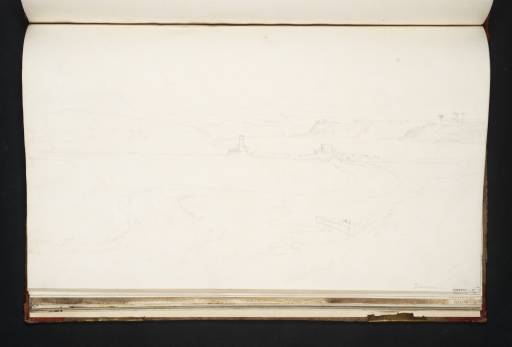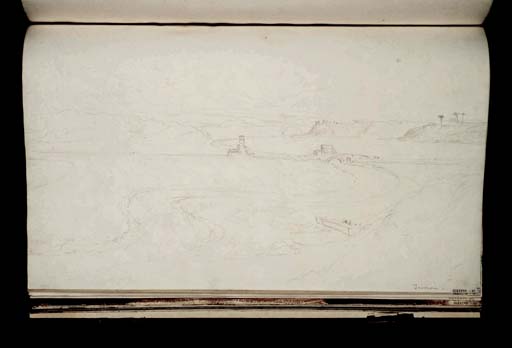Joseph Mallord William Turner The River Aniene with the Ponte Salario and Torre Salaria, Rome 1819
Image 1 of 2
Joseph Mallord William Turner,
The River Aniene with the Ponte Salario and Torre Salaria, Rome
1819
Joseph Mallord William Turner 1775–1851
Folio 37 Recto:
The River Aniene with the Ponte Salario and Torre Salaria, Rome 1819
D16125
Turner Bequest CLXXXVII 37
Turner Bequest CLXXXVII 37
Pencil on white wove paper, 255 x 403 mm
Inscribed by the artist in pencil ‘Teverone.’ bottom right
Inscribed by John Ruskin in blue ink ‘37’ bottom right, descending right-hand edge
Stamped in black ‘CLXXXVII 37’ bottom right
Inscribed by the artist in pencil ‘Teverone.’ bottom right
Inscribed by John Ruskin in blue ink ‘37’ bottom right, descending right-hand edge
Stamped in black ‘CLXXXVII 37’ bottom right
Accepted by the nation as part of the Turner Bequest 1856
References
1909
A.J. Finberg, A Complete Inventory of the Drawings of the Turner Bequest, London 1909, vol.I, p.556, as ‘Teverone’.
A large number of studies from the Naples: Rome C. Studies sketchbook represent variant views of the Roman Campagna, the area of countryside encircling the outskirts of the Eternal City (Tate D16122–D16139; Turner Bequest CLXXXVII 34–51). As Turner’s inscription in the bottom right-hand corner of this page indicates, this pencil sketch depicts the winding course of the River Aniene, a tributary of the Tiber also known as the Anio or Teverone. The main focus of the view is the Ponte Salario, a bridge which carried the Via Salaria (Salt Road) from the north of the city across the Aniene, close to where it joins the Tiber. To the left of the bridge is a watch-tower known as the Torre Salaria, or the Tomb of Mario, described by Ashby as ‘a large tomb of tufa concrete ... with a chamber in the form of Greek cross and a medieval tower above’.1 The bridge was destroyed in 1867 by Papal and French troops defending Rome against Giuseppe Garibaldi but the tower still survives today.2 Turner’s viewpoint appears to be from an area of high ground known as the Monte Antenne, now occupied by the Villa Ada park. The prospect looks east across the Campagna towards Tivoli and the distant Sabine mountains, in particular, the large peak of Monte Soracte which dominates the horizon.3
By the nineteenth century, exploration of the city’s environs had become as much part of the Roman experience as its architecture and monuments. Turner’s forays into the Campagna followed a long artistic tradition established during the seventeenth century by Claude Lorrain (circa 1600–1682) and Nicolas Poussin (1594–1665). The two French masters had famously made a number of sketching trips along the banks of the Tiber north of the city; indeed the countryside between the Porta del Popolo and the Ponte Molle had popularly become known as the ‘Promenade de Poussin’. The Ponte Salario was one of a number of landmarks which had become an established motif through the repertory of the ‘vedute’ tradition.4 Turner made detailed pencil studies of the structure on D41514; verso of Turner Bequest CLXXXVII 33, and D41482; verso of Turner Bequest CLXXXVII 34. Further general views include folio 38 (D16126) and D16122 (CLXXXVII 34), and see also the Small Roman C. Studies sketchbook (Tate D16459; CXC 45).
Thomas Ashby, The Roman campagna in Classical Times, 1927, quoted in Raymond Keaveney, Views of Rome from the Thomas Ashby Collection in the Vatican Library, exhibition catalogue, Smithsonian Institution, Washington 1988, pp.233–4.
For a photograph of the tower over the tomb see Oreste Ferrari, Tea Marintelli, Valerie Scott et al., Thomas Ashby: Un Archeologo Fotografa la Campagna Romana Tra ’800 e’900, Rome 1986, p.24, no.2 fig.1.
Compare Johann Christian Erhard, Ponte Solario with Mount Soracte in the Distance 1820 (Kunstmuseum Düsseldorf), reproduced in Philip Conisbee, Sarah Faunce and Jeremy Strick, In the Light of Italy: Corot and early Open-Air Painting, exhibition catalogue, National Gallery of Art, Washington 1996, p.57, fig.2, and in colour in Anna Ottani Cavina, Un Paese Incantato: Italia Dipinta da Thomas Jones a Corot, exhibition catalogue, Galeries nationales du Grand Palais, Parigi and Palazzo Te, Mantova, Italy 2001, no.129, p.214.
See for example views by Claude Lorrain, reproduced in Keaveney 1988, no.63, p.235; Giovanni Battista Piranesi, reproduced in Luigi Ficacci, Piranesi: The Complete Etchings, Köln and London 2000, no.918, reproduced p.711; and Giuseppe Vasi, reproduced at http://www.romeartlover.it/Vasi83.htm , accessed March 2009.
Verso:
Blank, save for being stamped in black ‘CLXXXVII 37’ and Turner Bequest monogram bottom left
Nicola Moorby
March 2009
How to cite
Nicola Moorby, ‘The River Aniene with the Ponte Salario and Torre Salaria, Rome 1819 by Joseph Mallord William Turner’, catalogue entry, March 2009, in David Blayney Brown (ed.), J.M.W. Turner: Sketchbooks, Drawings and Watercolours, Tate Research Publication, December 2012, https://www


